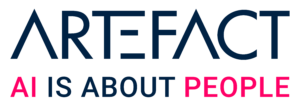AI for Finance Summit by Artefact - September 17th, 2024 - Paris
Key learnings from the opening speech by Joffrey Martinez, Partner & Global Financial Services Lead at Artefact.
AI’s rapid transformation of finance
Sixteen years ago, investment in traditional financial institutions seemed like a sure bet. However, the rapid rise of AI has proven that technology can outpace even the most established banks. In recent years, AI has significantly changed the financial landscape, from improving fraud detection with machine learning to making algorithmic trading more efficient. The most notable leap occurred in the last two years with generative AI (GenAI), which now allows technologies to display empathy in client interactions—a previously unimaginable milestone.
The challenge of scaling AI
Despite the breakthrough in AI capabilities and decreasing costs, only about 10% of financial companies successfully scale their AI initiatives. Most applications are limited to integrating tools like ChatGPT or Copilot into existing processes, resulting in difficulties measuring returns on investment, cost reduction, or increased customer satisfaction. The question becomes: what obstacles are preventing the successful use of AI, and how can these be overcome?
TIME: A framework for AI success
To address AI challenges, the solution lies in TIME—an acronym representing Transformation, Integration, Measurement, and Empowerment.
T as transformation
Achieving tangible results requires focusing on full-scale business transformation aligned with group strategy and priorities. Transformation must be end-to-end, not just adding technology to existing processes. For instance, optimizing cost-to-serve might mean working on back-office processes, while revenue-focused transformation could target distribution models and customer channels. The key is to decide where the value lies and commit fully.
I as integration
Legacy systems in financial services often create silos, making data access and quality control complex. The cloud and on-premises operations are rarely fully integrated. The focus should shift beyond infrastructure to ensure models are fully embedded within the data foundation and business processes. Leveraging “LLMOps”—a concept akin to DevOps but tailored for large language models—is crucial to integrating AI into the existing ecosystem effectively.
M as measurement
The paradigm has shifted from training models to measuring their impact and drift. Model development is becoming commoditized, but monitoring its performance in fraud detection, capital allocation, and customer interactions is paramount. A robust measurement framework involves observing issues, quantifying and understanding problems, and supervising the model’s business impact, ensuring continuous improvement.
E as empowerment
AI’s true value is in people. Success in AI deployment is tied to the empowerment and training of frontline workers. Real productivity gains can only be realized when the workforce is actively involved, trained, and ready to adopt AI tools. Thus, it’s essential to make sure the people closest to the operations are brought on board and understand how AI benefits their roles.
Balancing speed with time
AI requires time to transform deeply regulated environments and processes. However, the call to action is to act swiftly to gain a competitive advantage. As in any race, speed matters, but so does ensuring that each step of the transformation is solid. The conclusion is clear: give AI initiatives time, but act fast to stay ahead in this rapidly evolving landscape.






